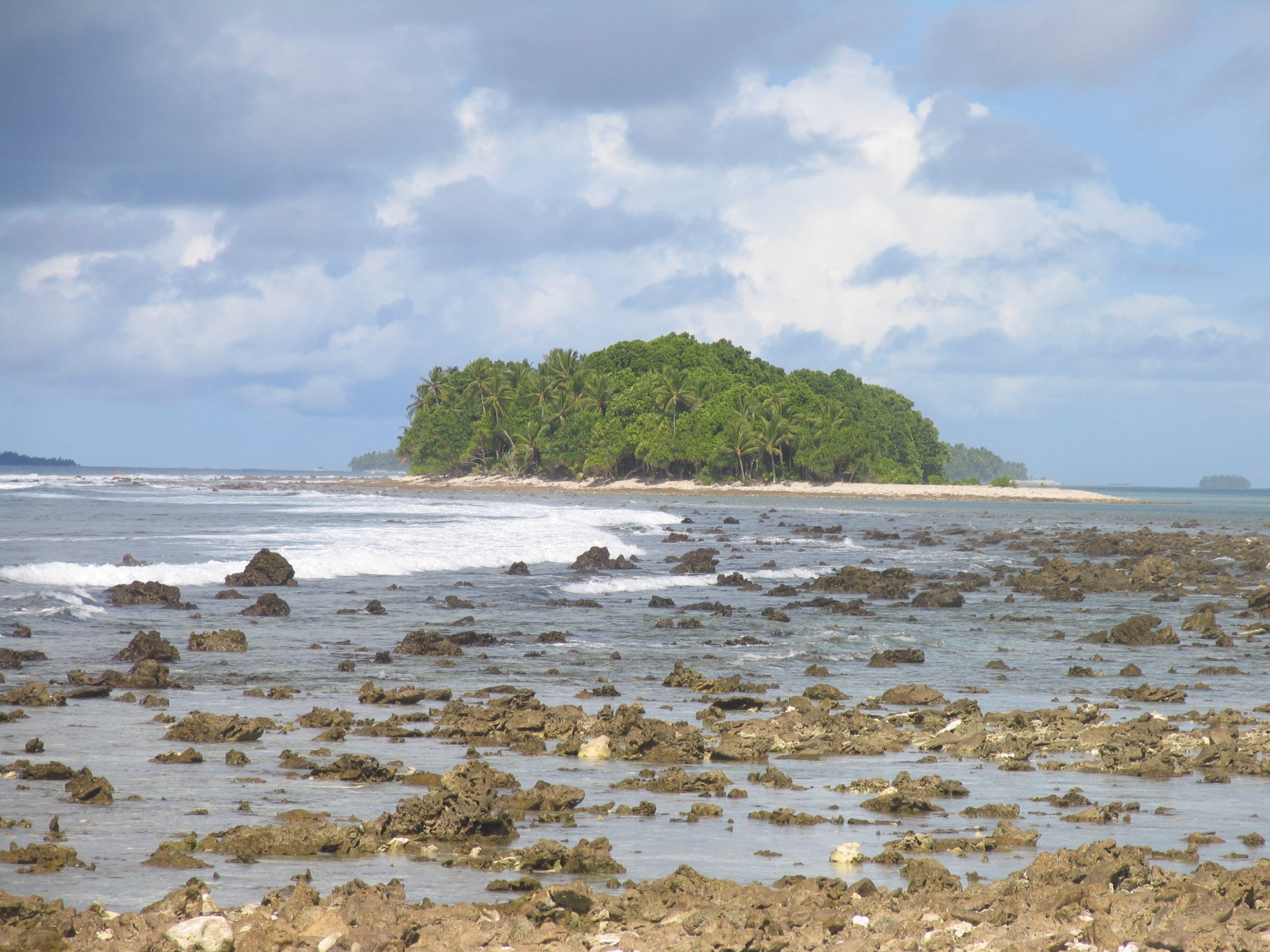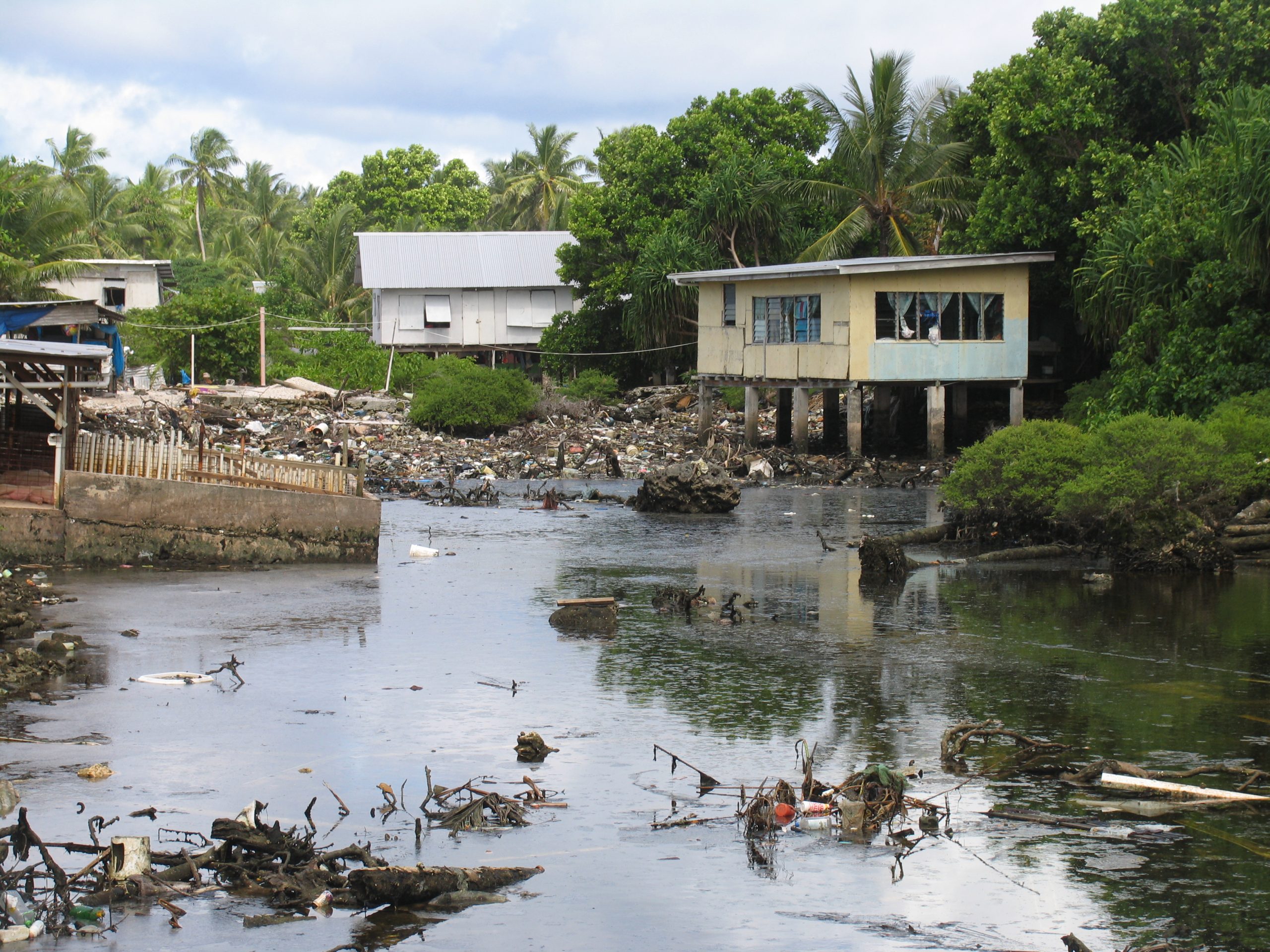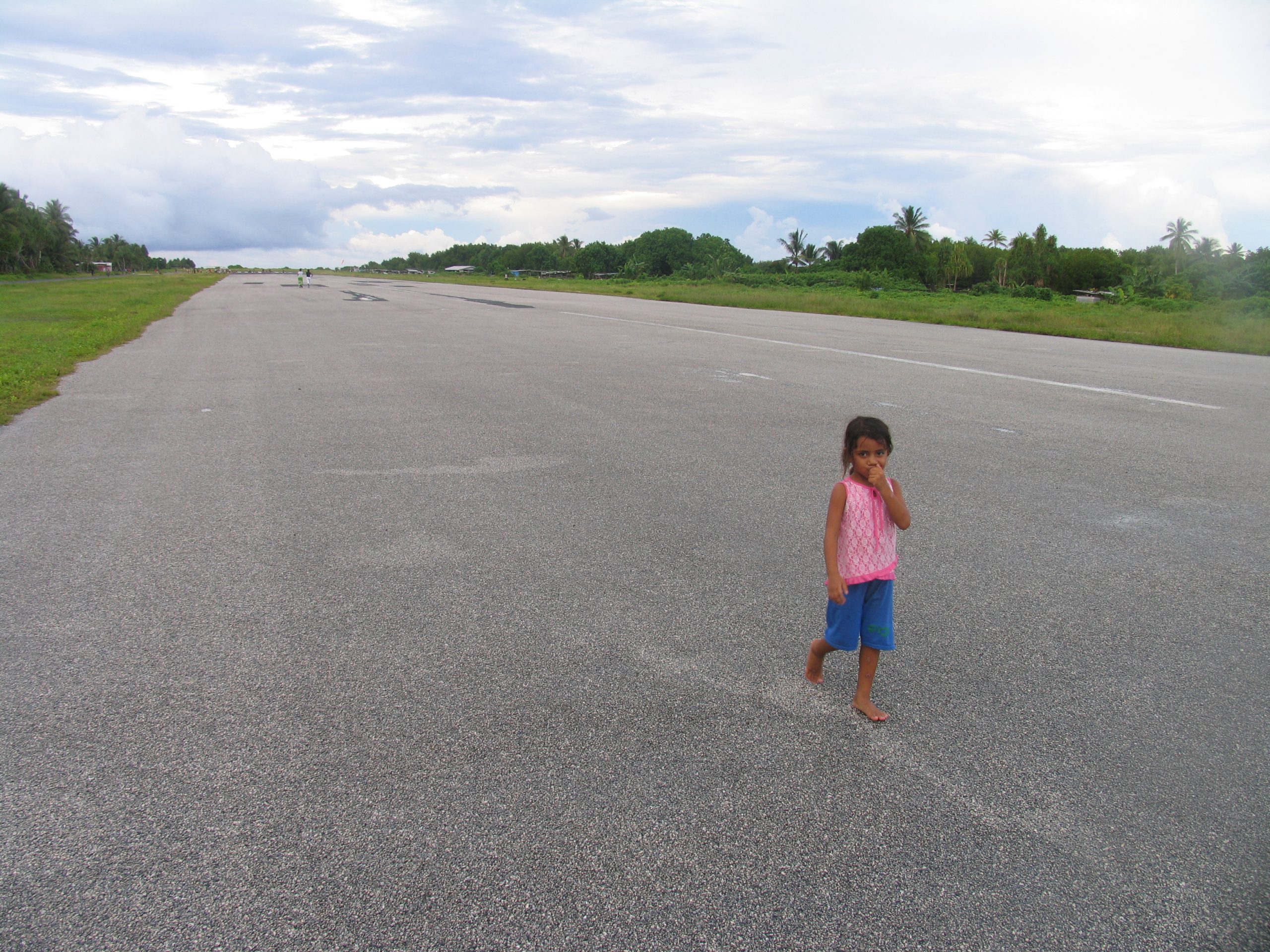Sinking. Tuvalu and the Pacific Islands in an Age of Global Warming
Andre Vltchek
Funafuti Atoll~A straight well-paved road leads to the northern tip of Fongafale Islet. In some places it is so narrow it feels like a causeway. Reverend Fr. Camille Desrosiers slowly drives his van pointing at modest landmarks of his adoptive country. He is 78 years old, originally from Quebec, Canada. He arrived in the Pacific in 1956 and never left, helping the impoverished people, drifting from one small island nation to another: first Samoa, later Tokelau now Tuvalu.
Once in a while he slows down his vehicle, pointing out a well-constructed house. “I built this one. And that one.” Asked whether he helped the families get funding for construction he responds with pride: “I physically built these houses. I rolled up my sleeves, brought my tools and built them.” What the Reverend built, the sea – ignobly and unwittingly aided by humans – may not be long in reclaiming.
Eventually the road ends. There is a small turn-around, and then stubs of palm trees and suddenly, endless fields of garbage. Plastic bags mix with rusting metal bars and obsolete or unidentifiable parts of heavy equipment.
As we drive back, the reverend notices old women squatting on the coral shore. “Tuvalu is an environmental disaster. These women look for shells to make necklaces, which they later sell either in the capital or to Fiji. Each necklace is sold for between 2 and 7 dollars, but this practice has to be stopped: the women are killing the creatures, destroying the coral.” He then points at the side of the road: “This road was built from materials imported from Fiji. Now we have weeds that we never had before. They built this beautiful road, but the imported weeds are growing fast, destroying our native vegetation. It’s symbolic of what is happening in this country!”
A few kilometers further south appear rusting cars with tropical vegetation filling their interior, growing through floors and seats. Near the shore, an old Korean cargo ship rots, surrounded by coral and the transparent beautiful waters of the South Pacific. Further toward the capital, the road passes garbage-filled lagoons known as “borrow pits,” where coral was extracted for the construction of a runway by the US military during WWII. Several men enjoy their siesta in hammocks hanging next to the garbage-filled lake. Countless pigs roam its shores.

Siesta in the hammock over the garage dump
Tuvalu appears to be both a natural and human-made disaster. Like Kiribati and the Marshall Islands, it is one of the small Pacific Island nations that may eventually become uninhabitable because of rising sea levels, flooding, king tides, vegetation loss and changes in rain patterns. (Tuvalu fully depends on rain water, having no wells and no rivers). Arguably it may be the first nation to disappear from world maps due to global warming. The sea-level rise has been about 20cm per decade in recent times. Consisting of four reef islands and five atolls, the highest point of Tuvalu is a mere 5 meters above sea level, with an average of 1-2 meters.
But there are other, even more immediate threats to survival: rubbish literally chokes this tiny nation. Hundreds of men and women are leaving outlying atolls and islands and others are leaving the country altogether, abandoning Tuvalu in the midst of what should be its battle for survival.
Although Tuvalu is dispersed over 1.3 million square kilometers of the central Pacific, its total surface is only 26 square kilometers, making it the 4th smallest nation on earth after the Vatican, Monaco and Nauru. Nearly half its population of 12,000 is now squeezed between the garbage dumps and the deep blue sea, and the government is unable or unwilling to deal with the problem. Traditional means of livelihood are almost forgotten and the country now fully depends on low-quality imported food, mostly canned. Food packaging is one of the main sources of pollution on Funafuti Atoll. Fongafale Islet also bears a ridiculous number of cars, given that the island has only one 12km road. Many vehicles, including several SUVs, are parked in front of the large Taiwan-constructed government building. The capital is also dotted with decomposing fax machines, copiers, scanners and other office supplies. Arriving from abroad as part of foreign aid, this equipment is rarely used and never maintained but is always replaced.
The country is fully dependent on foreign aid. Most of the population is involved in subsistence fishing, but the monetary economy is dominated by the government which sells fishing licenses and markets its internet domain name ‘.tv’ but above all demands and receives substantial foreign aid. Australia, New Zealand, the UK as well as Japan and South Korea have made major contributions to The Tuvalu Trust Fund which was set up in 1987, its sole purpose to help the country survive. All major projects, from a deep water wharf to the hospital and roads were financed by foreign aid, mostly governmental. Australia is Tuvalu’s most significant ‘development partner’; total Australian aid to Tuvalu in 2006/07 is budgeted at $5.4 million. ODA for 1970-2003 was 89 percent of Tuvalu’s GDP (according to David Fielding of the University of Otago, NZ), compared to 39.7 percent of GDP in neighboring Kiribati, a nation battered by global warming to a similar degree to Tuvalu. Like almost all nations in the region, Tuvalu plays the lucrative Taiwan/China game: it recognizes Taiwan as an independent country and so receives from Taipei a substantial though undisclosed amount of aid in return.
As a rule, dependency on foreign aid in the Pacific breeds corruption. The Berlin-based Transparency International described one type of corruption in Tuvalu as “per diem mentality.” In its 2004 report on Tuvalu it pointed out that: “…’per diem’ mentality is… very much present in the attendance of meetings – e.g. regional meetings, in-country workshops – or other trips oversees… Ministers had been suspected of overstaying and still receiving per diems and changing international travel for personal reasons…” A ban on foreign travel for government officials imposed by the present administration did not last long. Officials in most Pacific island nations assure themselves of traveling abroad for a substantial part of the year. Despite modest incomes, many officials have residences in Australia or New Zealand and their children often study abroad. Personal gain comes ahead of national interest.
Foreign aid keeps flowing in regardless of the performance of the local government. While millions of dollars pour into this tiny country, there appears to be no attempt to use the money to address the most pressing issues: garbage keeps piling up and there is apparently no effort to implement waste management programs. Meanwhile, people leave the remote atolls and islands which lack almost all necessities. Many government officials see no feasible way to solve the country’s problems. The world community feels sympathetic toward this country that may disappear, a victim to the unbridled consumption of industrialized nations translated into global warming.
Kelesoma Sanoa, the Prime Minister’s Personal Assistant, frequently handles environmental issues: “I think that waste is as great a challenge for this country as is climate change,” he explains. “We have to get serious about waste. It is an enormous problem that we have to face. Our people depend on imports. Their mentality is still that if they throw things on the ground, it is going to eventually decompose. They are not used to dealing with plastic and metals. There are several illegal dumping sites. We have to change our people’s mentality.”
Just 3 kilometers southwest of the government building, in an area known as Tekavatoetoe, a young man looks over a “borrow pit” filled with rubbish. His house is built on stilts and the view from his patio is of an enormous deposit of plastic and metal garbage. He is reluctant to use his real name but ready to offer an assessment of the situation:
“Our government has a tendency to blame everything on the people. They say that we lack discipline in making illegal garbage dumps. Almost all the so-called illegal rubbish pits were created by the government or by the Town Council. In this community, we protested and complained for years, but our voices were never heard. Some time ago we had to physically stop the government from dumping more rubbish here. We were ready to fight. Until this, no measures had been taken to clean up our land.”
More than an hour boat ride from Fongafale, idyllic Funafala Islet looks like a stereotype of tropical paradise – white sand beaches and coral, tall palm trees – but in recent decades, this island has lost almost its entire population. Former residents moved to Fongafale and foreign countries, particularly New Zealand. Now there are only 5 families left, surviving on subsistence fishing and crafts.
Folavu is 67 years old. Funafala Islet has been his home his entire life, and he has no intention of moving.
“They keep talking about the sea-level rise, but I don’t think we have to leave our island for centuries to come,” he says. “Ever since I can remember, people here have built their houses on stilts. Water comes and goes. Last week the waves rolled over the entire island and look, we are still here, and so are our houses. They say that seawater salt destroys agriculture, but we don’t cultivate anything here. People of Funafala are fishermen and craftsmen. I was born here and I want to die here, if they let me.”
In terms of basic services like drinking water, electricity, transportation, medical care and schools, there is very little help that places like Funafala may expect from the government, which, it seems, wants the local population to move to the main island. For many inhabitants of Tuvalu’s outer islands and remote atolls, a move from their homes to Fongafale represents a first step on a path that eventually leads them out of the country.
Kesia, a middle class employee from the capital, visits Funafala almost every year with her daughter Letisha. They come to admire the serene beauty of the island where Letisha learns from an early age about the traditional life of her threatened nation.
“People come here and take pictures, because they realize that our traditional lifestyle may soon disappear,” says Kesia with melancholy, viewing the lush tropical vegetation. The lively colors offer a striking, almost unreal contrast to the sheer white of sand and coral. Nearby, an old woman caresses her small granddaughter, both slowly rocking in a hammock hung next to the beach. “It seems our government thinks if it moves us all to the capital, there will be no need to do anything for the outlying islands. They don’t force us to leave: they just do nothing for our communities. And the sea-level rising is an excellent excuse. It also takes much less effort to declare the country to be ‘beyond salvation’ and then demand aid as compensation, than to try to fight for its survival. Some of my neighbors in the capital have already migrated to New Zealand, some to Fiji. In the outer islands like this, people can hardly resist; they have no schools and no medical centers. Young people are forced to move to the capital to attend school. This way, nobody takes care of the elderly people who have to eventually follow. There is only one boat on this island and it is private. To hire it costs 40 Australian dollars one way to get to the capital. Nobody can pay this price and there is no public transportation available. This island used to have well over one hundred inhabitants, now it has only 20 left.”
Back in the capital, David Manuela, Centre Director of the University of the South Pacific (USP) expresses his frustration: “Tuvalu can’t withstand the impact of the greenhouse effect. There were areas that, during the recent flood, lay 40cm below sea level. At the present speed of rising sea levels, the country can survive only 50 more years. The United States keeps asking the global community what it is doing to combat terrorism. But I would like to ask, what is it doing to prevent Pacific Island Nations from disappearing? Waves are rolling over Tuvalu. It is not our fault that global warming is taking place. The issue is how can the rich world help Tuvalu.”
After lamenting, Manuela unveils his plan, which seems identical to the government’s own. According to him, saving Tuvalu would be too costly. The best way is relocation: move the people to some Australian islands between PNG and the Northern Territories, give them autonomy and extensive foreign aid. Asked why the people should be moved to Australia, which is not the major polluter, instead of to China or Russia or the United States, Mr. Manuela responds that Australia is Tuvalu’s close friend. This omits the fact that Australian Prime Minister John Howard consistently refuses to even meet his Tuvalu counterpart and discuss the issue. It seems that Australia feels it is already doing too much for its unfortunate neighbor. So far only New Zealand has begun accepting (since 2001) 75 Tuvaluans a year – only those, however, who are under 45 and relatively well educated. This is leading to a brain drain. Australia has not acknowledged any prospect of climate refugees.
There are other major concerns, one of them expressed by Sumeo Silu, director of the National Disaster Management Office: “If we were to face the same situation as Aceh or Southern Thailand, if a tsunami were to hit Tuvalu, our casualty rate would be 100 percent. Nobody would survive. There is a lot of talk about the dangers we face, but not much is being done. It saddens me to say it, but despite everything, Tuvalu is not better prepared to face disasters than it was in the past.”

Sumeo Silu, Director of the National Disster Management Office
Many leading environmental scientists argue that Tuvalu suffers not only from global warming, but also from other forms of human-made environmental destruction that are wiping out its coral and mangroves, and suffers in particular from the unwillingness of its leaders to take the action needed to avoid the ultimate disappearance of their own country.
Just a few minutes walk from the USP, the Assembly Hall of Laopou Village is hosting the annual “Fatele” dance and music performance. Two large traditional cultural troops compete against each other in a vibrant, breathtaking spectacle. Tuvalu music and dance traditions are some of the most compelling in Polynesia. Observing the pride and zeal of the performers, it appears highly unlikely that if given the choice, these determined people would be ready to abandon their little country to a bleak fate, without a fight. Despite its size, Tuvalu is undeniably a real country. It has its own language, its own traditions and arts, and is inseparable from its geography and environment.
Espen Ronneberg is less than enthusiastic about the prospects of evacuation of the entire nation. He served as Vice-President of the Kyoto Conference in 1997 that adopted the Kyoto Protocol and is now working as Climate Change Advisor at the Secretariat of the Pacific Environmental Programme (SPREP). “The bottom line is that Small Island States – like Tuvalu, Kiribati, and Marshall Islands – are very vulnerable to climate variability and extreme weather events right now because of their unique geographic and physical attributes, combined with a number of other factors. But it also has to be acknowledged that a lot of human activity on some islands is very detrimental to the resilience of their natural defense systems. My organization is working with these countries to formulate assessments and plans for adapting to climate change, so that near term impacts can be addressed, and that longer-term impacts can be prepared for. Given the predictions of science, however, it is clear that without strong measures to reduce global greenhouse gas emissions, comprehensive adaptation in many of these islands will be very difficult. Potential evacuation of islands though raises grave concerns over sovereignty rights as well as the unthinkable possibility of entire cultures being damaged or destroyed. We have seen the social impacts on populations internally displaced in the Pacific – due to nuclear testing, phosphate mining and other causes – and it does not augur well for the future.”
According to many government officials, Tuvaluans have no choice: the country has to be evacuated. The majority of the citizens of this atoll nation do not share this opinion. Some don’t realize the decision has already been made far away – in the air-conditioned offices of the government building in the capital. As if to prove the point that nothing can be done to save the country from disappearing, the government fails to “defend Tuvalu”: garbage piles up all over the archipelago, coral mixes with rubbish and is bleached, mangroves die. And all the while the seawaters rise: slowly but steadily.
This is a revised and expanded version of an article that was published in Newsweek, Japan on 28 June 2007 and APA/Asiana Press Agency. Posted at Japan Focus on September 1, 2007.
Andre Vltchek, novelist, playwright, filmmaker and journalist, is Editorial Director of Asiana Press Agency, and co-founder of Mainstay Press. Author of several books, including his latest novel “Point of No Return” describing the “New World Order” from the perspective of war correspondents. He is presently working in Asia and the South Pacific and can be reached at [email protected]. His homepage and blog are available here.
His interview with Espen Ronneberg “Climate Change and the Threat to Pacific Island Nations” is available here on Japan Focus.
His article “The New Pacific Wall: The U.S., Australia, and New Zealand Isolate and Divide Small Insular Nations” is also available at Japan Focus. Click here to view.











